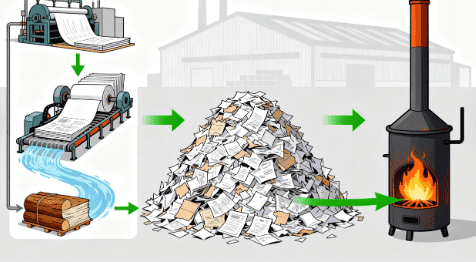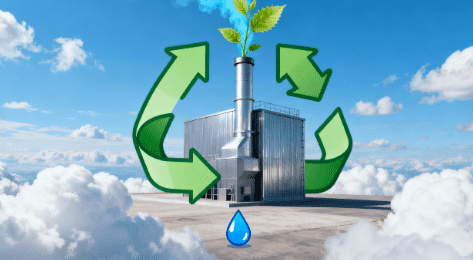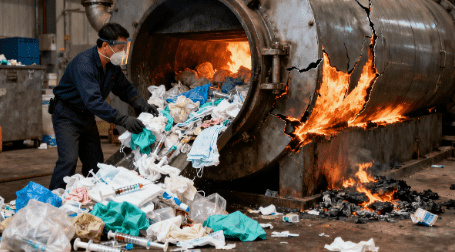Table of Contents
Introduction

In the paper manufacturing industry, waste management is an ongoing challenge. Paper mills generate large amounts of waste, ranging from paper trimmings and rejects to dust and other residues. Traditional waste disposal methods, such as landfilling or recycling, often do not fully meet the needs of high-volume paper mills. This is where paper incinerators come into play, offering a more efficient, environmentally friendly solution for handling paper mill waste. In this blog, we will explore how paper incinerators help paper mills overcome waste disposal challenges, improve environmental impact, and enhance operational efficiency.
The Role of Paper Incinerators in Paper Mill Waste Management
How Paper Incinerators Improve Waste Disposal Efficiency
One of the most significant advantages of paper incinerators is their ability to manage large volumes of paper waste efficiently. Instead of sending waste to landfills or attempting complicated recycling processes, paper incinerators burn the waste, converting it into heat energy that can be used to power other processes in the mill. This not only reduces the waste pile but also provides an additional energy source, creating a more sustainable operation.
In addition to reducing waste volume, paper incinerators help streamline waste disposal by automating the process. This reduces the need for manual sorting and handling of waste, saving time and reducing labor costs. The result is a smoother and more cost-effective waste management process in paper mills.
The Environmental Benefits of Paper Incinerators
As global sustainability initiatives intensify, paper mills are under increasing pressure to reduce their environmental footprint. Paper incinerators offer a solution by turning waste into energy while minimizing harmful emissions. Modern paper incinerators are equipped with advanced filtration systems that capture particulates and gases, reducing air pollution and ensuring compliance with environmental regulations.
Furthermore, paper incinerators contribute to paper mill sustainability efforts by reducing the need for waste transportation. Waste that would otherwise be hauled to landfills can now be safely incinerated on-site, significantly lowering the carbon footprint associated with waste disposal.
The Economic Advantages of Using Paper Incinerators in Paper Mills

Reducing Paper Mill Operating Costs
One of the major concerns for paper mills is managing operating costs while maintaining production efficiency. Paper incinerators offer several economic benefits. By incinerating waste onsite, paper mills can reduce waste disposal fees, which are often high for large-scale operations. Additionally, since paper incinerators convert waste into energy, they can offset part of the mill’s energy consumption, further lowering operational costs.
Moreover, paper incinerators have a relatively low maintenance cost when compared to other waste management systems. With minimal maintenance required and a longer lifespan than some alternative methods, paper mills can enjoy significant savings in the long run.
How Paper Incinerators Help Paper Mills Achieve Green Certifications
Many paper mills are striving to achieve green certifications such as ISO 14001, which recognizes efforts to improve environmental performance. Paper incinerators help mills meet these certification standards by ensuring that waste is handled in an environmentally responsible manner. By reducing waste sent to landfills and decreasing emissions, paper mills can demonstrate their commitment to sustainability, which can be a selling point for customers and partners.
Paper Incinerators vs. Traditional Waste Disposal Methods
How Paper Incinerators Compare to Landfilling and Recycling
When it comes to managing waste, paper mills have traditionally relied on landfilling or recycling. However, both methods have their limitations. Landfilling contributes to environmental pollution and takes up valuable space, while recycling can be costly and time-consuming. Paper incinerators offer a more efficient alternative, with several advantages over these traditional methods.
Here’s a comparison of paper incinerators vs. landfilling and recycling:
| Feature | Paper Incinerators | Landfilling | Recycling |
|---|---|---|---|
| Waste Reduction | Up to 95% waste reduction | Only about 50-60% waste reduction | 70-90% waste reduction, depending on process |
| Energy Generation | Converts waste into usable energy | No energy recovery | No energy recovery |
| Environmental Impact | Low emissions with filtration systems | High environmental impact | Moderate environmental impact |
| Cost Efficiency | Lower operational and disposal costs | High transportation and landfill fees | High operational costs and sorting costs |
| Compliance with Regulations | Meets strict emissions standards | Often does not comply with regulations | Meets some environmental standards, depending on technology |
How Paper Incinerators Address the Challenges of High-Volume Paper Waste
High-volume paper mills face the challenge of processing large quantities of waste, often generated in continuous production cycles. Paper incinerators are designed to handle these high-volume waste streams efficiently. Unlike recycling or landfill methods, which may require additional processing or transportation, paper incinerators can process vast amounts of waste on-site, ensuring smooth operations.
How Paper Incinerators Contribute to Sustainable Paper Mill Operations

Achieving Waste-to-Energy Goals in Paper Mills
As part of their sustainability efforts, many paper mills aim to implement waste-to-energy (WTE) systems. Paper incinerators are a key component in achieving these goals. By converting paper waste into heat or electricity, mills can reduce their dependency on external energy sources, which are often costly and environmentally harmful. This not only cuts costs but also reduces the carbon footprint of the mill.
Moreover, using paper incinerators for energy production aligns with growing global efforts to reduce greenhouse gas emissions. It provides an opportunity for paper mills to transition to more eco-friendly, self-sustaining operations.
How Paper Incinerators Enhance Overall Paper Mill Waste Control
Paper incinerators play a crucial role in improving overall waste control in paper mills. By incinerating waste, mills can reduce the need for landfills, cutting waste disposal costs. Additionally, because these systems provide energy recovery, they support the mill’s operational efficiency. Combined with advanced air filtration and waste management technologies, paper incinerators ensure that waste is handled safely and responsibly.
Conclusion
Paper incinerators are a game-changer in the paper industry, offering a multifaceted solution to waste disposal challenges in paper mills. They improve operational efficiency, reduce environmental impact, and provide a cost-effective, sustainable alternative to traditional waste disposal methods. With their ability to handle high-volume waste, convert waste into energy, and meet regulatory standards, paper incinerators are increasingly becoming a critical piece of waste management solutions for paper mills worldwide.
As the paper industry continues to face increasing pressure to become more sustainable, paper incinerators offer a viable path forward. By embracing this technology, paper mills can not only reduce their waste and energy costs but also contribute to a greener, more sustainable future.
FAQ
1. What is a paper incinerator?
A paper incinerator is a specialized furnace designed to burn paper waste, converting it into energy in the form of heat or electricity. It significantly reduces the volume of waste and helps paper mills manage waste disposal efficiently.
2. How does a paper incinerator work?
A paper incinerator burns paper waste at high temperatures, using advanced filtration systems to minimize harmful emissions. The heat generated can be used to power other parts of the paper mill, improving overall energy efficiency.
3. Are paper incinerators environmentally friendly?
Yes, modern paper incinerators are designed to minimize environmental impact. They use advanced air filtration systems to capture harmful pollutants and comply with strict emissions standards, ensuring responsible waste disposal.
4. How much waste can a paper incinerator handle?
The capacity of a paper incinerator depends on the model and size. However, most are designed to handle high volumes of waste, making them suitable for large-scale paper mills that generate significant amounts of waste daily.
5. Are paper incinerators cost-effective for paper mills?
Yes, paper incinerators can significantly reduce operational costs by cutting down waste disposal fees, reducing landfill use, and even providing energy savings. Over time, the savings from reduced waste management and energy costs can outweigh the initial investment.






